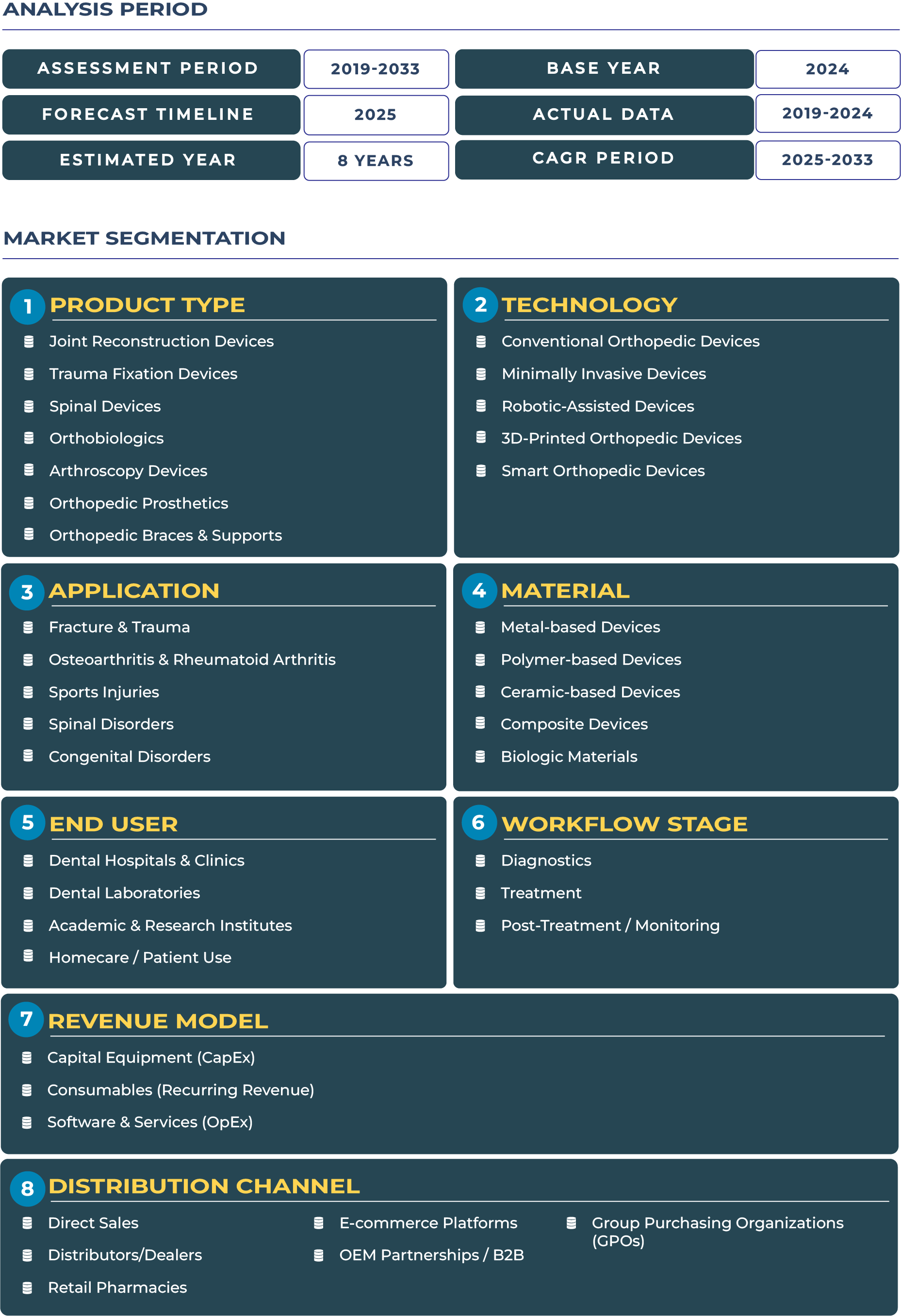Colombia Orthopedic Devices Market: Colombia’s Rise as a Medtech and Orthopedic Tourism Hub Driving Market Growth
Colombia has rapidly emerged as a leading hub for orthopedic medical tourism in Latin America, fueled by its combination of advanced private healthcare facilities, highly trained surgeons, and cost-effective procedures. The nation’s strong medtech positioning is attracting patients from North America, Europe, and neighboring Latin American countries who are seeking orthopedic care such as trauma fixation, joint reconstruction, and minimally invasive arthroscopy. This rising flow of international patients is creating consistent demand for advanced medical devices and surgical technologies.
By 2025, Colombia orthopedic devices market is projected to reach USD 404.8 million, expanding to USD 732.1 million by 2033 at a CAGR of 7.7%. This growth is underpinned by investments in private hospital infrastructure, expansion of insurance coverage, and the country’s ability to offer competitive orthopedic care at lower costs compared to developed nations. The trajectory of this market reflects Colombia’s evolving position as a regional medical hub where high-quality orthopedic devices are increasingly integrated into surgical care pathways.
Orthopedic Devices Ecosystem Strengthened by Colombia’s Private Healthcare and Tourism Surge
The outlook for Colombia orthopedic devices industry is closely tied to the synergy between private sector expansion and medical tourism. With the Ministry of Health and Social Protection of Colombia supporting modernization, the orthopedic devices sector is gaining momentum across urban healthcare systems in Bogotá, Medellín, and Cali. Joint reconstruction procedures and prosthetics are particularly in demand, as an aging population and an influx of international patients converge on specialized orthopedic clinics.
Private hospital groups are making sizable investments in equipment upgrades and surgical capabilities, integrating spinal devices and orthobiologics into advanced treatment portfolios. The strong presence of skilled clinicians further strengthens Colombia’s orthopedic ecosystem, positioning it as a credible destination for complex procedures. While economic headwinds and payer fragmentation remain challenges, the orthopedic devices landscape is becoming increasingly resilient, supported by consistent growth in both domestic and international patient volumes.
Growth Drivers and Structural Barriers Defining Colombia Orthopedic Devices Market
One of the most prominent growth drivers for Colombia Orthopedic Devices sector is the expansion of insurance coverage, which improves accessibility to surgical interventions. Private hospitals are rapidly investing in orthopedic infrastructure, building dedicated wings for trauma, joint replacement, and minimally invasive procedures. The rising reputation of Colombia as a regional center for medical tourism also boosts demand, as patients from the United States and Europe choose Colombia for affordable yet advanced orthopedic surgeries.
However, structural barriers hinder seamless growth. Colombia’s fragmented payer landscape complicates reimbursement for orthopedic procedures, particularly in public hospitals. Security and transport logistics in certain regions limit device distribution and timely patient access, especially for advanced implants. Price sensitivity across the healthcare system creates additional pressure, requiring suppliers to offer differentiated tiers of devices. Despite these hurdles, the resilience of Colombia Orthopedic Devices ecosystem lies in its ability to adapt through innovative financing, partnerships, and localized strategies.
Trends and Opportunities: Urban Consolidation, Ambulatory Growth, and Outcomes Partnerships Redefining Orthopedic Adoption
Emerging trends are reshaping Colombia orthopedic devices market, with consolidation of private chains in Bogotá and Medellín leading the way. Hospitals and ambulatory surgical centers are increasingly adopting minimally invasive arthroscopy devices to reduce patient recovery times and enhance surgical efficiency. Another major trend is the rising interest in orthobiologics, as both clinicians and patients seek advanced regenerative therapies for joint and spinal conditions.
Opportunities are abundant for companies that align their strategies with local market needs. Partnerships with private hospital chains open avenues for volume-driven adoption, while tiered pricing strategies allow suppliers to cater to different socioeconomic groups. Clinical outcomes partnerships, where suppliers demonstrate superior results in trauma fixation or joint replacement, provide a pathway to justify higher price points. As Colombia’s healthcare system emphasizes value-based care, these opportunities will define how stakeholders capture market share in an increasingly competitive orthopedic devices sector.
Competitive Landscape: International Leaders and Local Partnerships Driving Market Penetration
The competitive environment of Colombia’s orthopedic devices industry is shaped by both multinational corporations and local distributors. Companies such as Stryker have established a strong footprint in joint reconstruction and trauma fixation, while regional distributors supply cost-sensitive implants across public and mid-tier hospitals. Market players are increasingly adopting flexible strategies such as partnering with private chains, implementing tiered pricing models, and launching outcomes-based pilot programs to remain competitive.
Bogotá and Medellín serve as the focal points for advanced orthopedic adoption, with collaborations between hospitals and device suppliers accelerating uptake of spinal implants and advanced prosthetics. Local firms complement multinational innovation by catering to affordability-driven segments, ensuring broader access to devices across Colombia. With the orthopedic devices landscape becoming more diverse, the competitive dynamics highlight a blend of global expertise and localized market execution.







